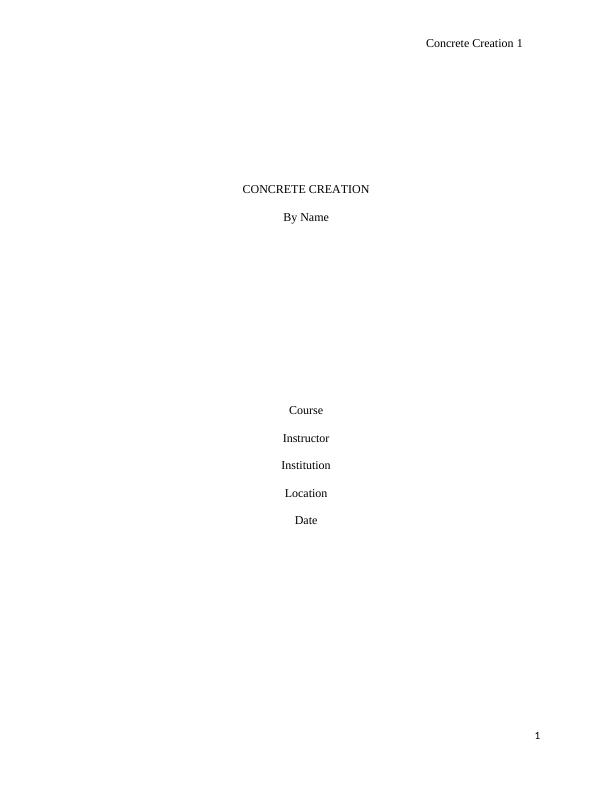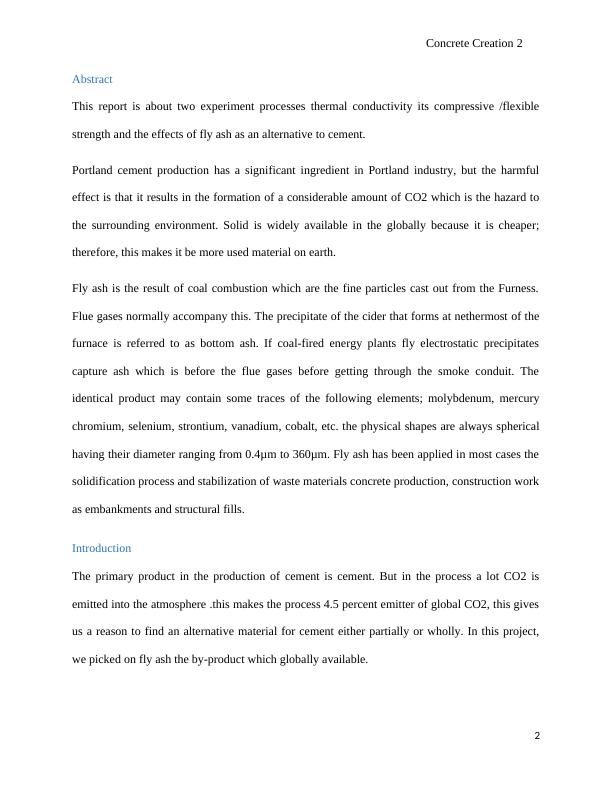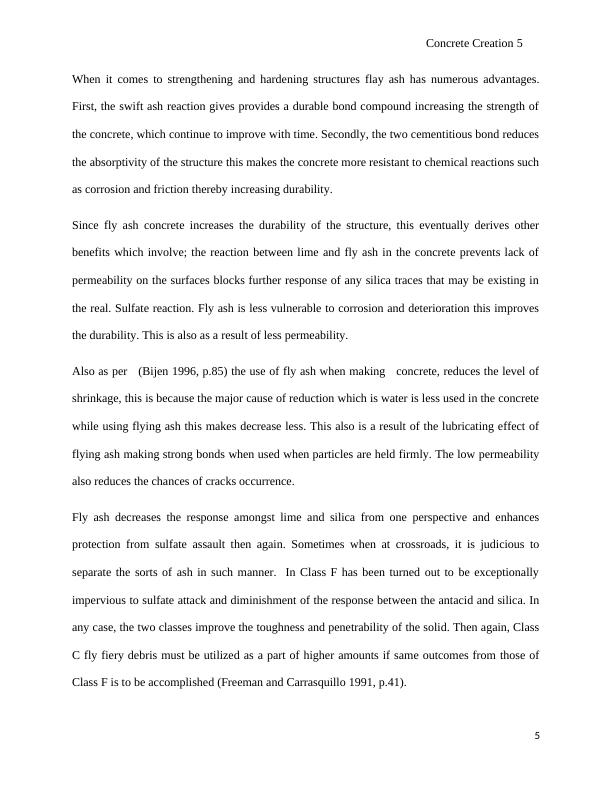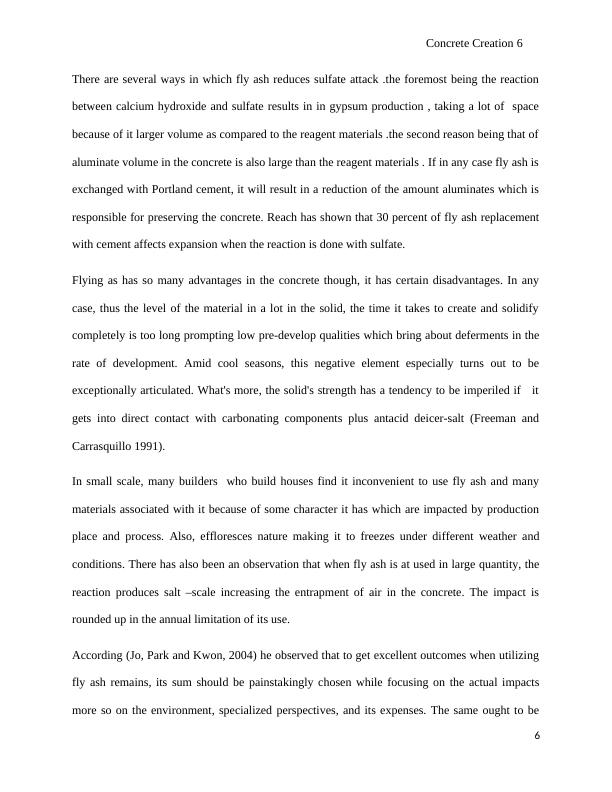Fly Ash as an Alternative to Cement in Concrete Production
Added on 2023-06-11
23 Pages5721 Words291 Views
Concrete Creation 1
CONCRETE CREATION
By Name
Course
Instructor
Institution
Location
Date
1
CONCRETE CREATION
By Name
Course
Instructor
Institution
Location
Date
1

Concrete Creation 2
Abstract
This report is about two experiment processes thermal conductivity its compressive /flexible
strength and the effects of fly ash as an alternative to cement.
Portland cement production has a significant ingredient in Portland industry, but the harmful
effect is that it results in the formation of a considerable amount of CO2 which is the hazard to
the surrounding environment. Solid is widely available in the globally because it is cheaper;
therefore, this makes it be more used material on earth.
Fly ash is the result of coal combustion which are the fine particles cast out from the Furness.
Flue gases normally accompany this. The precipitate of the cider that forms at nethermost of the
furnace is referred to as bottom ash. If coal-fired energy plants fly electrostatic precipitates
capture ash which is before the flue gases before getting through the smoke conduit. The
identical product may contain some traces of the following elements; molybdenum, mercury
chromium, selenium, strontium, vanadium, cobalt, etc. the physical shapes are always spherical
having their diameter ranging from 0.4μm to 360μm. Fly ash has been applied in most cases the
solidification process and stabilization of waste materials concrete production, construction work
as embankments and structural fills.
Introduction
The primary product in the production of cement is cement. But in the process a lot CO2 is
emitted into the atmosphere .this makes the process 4.5 percent emitter of global CO2, this gives
us a reason to find an alternative material for cement either partially or wholly. In this project,
we picked on fly ash the by-product which globally available.
2
Abstract
This report is about two experiment processes thermal conductivity its compressive /flexible
strength and the effects of fly ash as an alternative to cement.
Portland cement production has a significant ingredient in Portland industry, but the harmful
effect is that it results in the formation of a considerable amount of CO2 which is the hazard to
the surrounding environment. Solid is widely available in the globally because it is cheaper;
therefore, this makes it be more used material on earth.
Fly ash is the result of coal combustion which are the fine particles cast out from the Furness.
Flue gases normally accompany this. The precipitate of the cider that forms at nethermost of the
furnace is referred to as bottom ash. If coal-fired energy plants fly electrostatic precipitates
capture ash which is before the flue gases before getting through the smoke conduit. The
identical product may contain some traces of the following elements; molybdenum, mercury
chromium, selenium, strontium, vanadium, cobalt, etc. the physical shapes are always spherical
having their diameter ranging from 0.4μm to 360μm. Fly ash has been applied in most cases the
solidification process and stabilization of waste materials concrete production, construction work
as embankments and structural fills.
Introduction
The primary product in the production of cement is cement. But in the process a lot CO2 is
emitted into the atmosphere .this makes the process 4.5 percent emitter of global CO2, this gives
us a reason to find an alternative material for cement either partially or wholly. In this project,
we picked on fly ash the by-product which globally available.
2

Concrete Creation 3
Fly as can revolutionize the construction industry if used as an ingredient in the process of
cement manufacture. The main reason for this is that it does not emit toxic gases into the
atmosphere as compared to Portland cement products. This makes fly ash suitable since it is
environmentally friendly (Mehta, 1985).
The alternative product such as crude oil is mostly non-renewable, and it’s depleted in supply.
Coal was used as an alternative. For example, over 450 million kgs of coal fly ash were extracted
globally with us contributing a tenth. When this scenario is viewed as an economic point of view
fly ash is cheaper therefore worth investing in. This makes fly as a perfect replacement of
concrete (Freeman and Carrasquillo, 1991).
Fly ash is pozzolanic chemically (Freeman and Carrasquillo, 1991). Therefore, the chemical
reaction that occurs when aluminous and siliceous material which forms cement when reacted
with calcium hydroxide.
Hydrated Calcium silicate and lime are as a result of hydrating the cement from Portland. When
hydrated calcium silicate loses water, it turns into hard substance leaving some voids which are
filled with lime. The reaction between fly ash and lime gives hydrated calcium silicate as a result
(this is same as the product of Portland cement) this is what enhances the strength of concrete.
The precautionary measures have to be observed while using fly ash to achieve desired strength
and durability. The mixing ratios have to be followed for one to complete goals .the content of
fly ash should also be observed when choosing it to be satisfactory. Usually, the mass of fly shy
which is supplied to structural concrete is approximate of 20-40 percent .for parking lots,
concrete roadways, roller –compressed and bulk concrete for barrages is around 75 percent
(Dunstan, 1983)
3
Fly as can revolutionize the construction industry if used as an ingredient in the process of
cement manufacture. The main reason for this is that it does not emit toxic gases into the
atmosphere as compared to Portland cement products. This makes fly ash suitable since it is
environmentally friendly (Mehta, 1985).
The alternative product such as crude oil is mostly non-renewable, and it’s depleted in supply.
Coal was used as an alternative. For example, over 450 million kgs of coal fly ash were extracted
globally with us contributing a tenth. When this scenario is viewed as an economic point of view
fly ash is cheaper therefore worth investing in. This makes fly as a perfect replacement of
concrete (Freeman and Carrasquillo, 1991).
Fly ash is pozzolanic chemically (Freeman and Carrasquillo, 1991). Therefore, the chemical
reaction that occurs when aluminous and siliceous material which forms cement when reacted
with calcium hydroxide.
Hydrated Calcium silicate and lime are as a result of hydrating the cement from Portland. When
hydrated calcium silicate loses water, it turns into hard substance leaving some voids which are
filled with lime. The reaction between fly ash and lime gives hydrated calcium silicate as a result
(this is same as the product of Portland cement) this is what enhances the strength of concrete.
The precautionary measures have to be observed while using fly ash to achieve desired strength
and durability. The mixing ratios have to be followed for one to complete goals .the content of
fly ash should also be observed when choosing it to be satisfactory. Usually, the mass of fly shy
which is supplied to structural concrete is approximate of 20-40 percent .for parking lots,
concrete roadways, roller –compressed and bulk concrete for barrages is around 75 percent
(Dunstan, 1983)
3

Concrete Creation 4
The use of fly as a replacement of cement material dates back to the 19th century but the use of
the same was at the beginning of 20th century .this was as a result of pioneer research of the
University of California, this discovery has led to many million tons of fly ash use more so in the
united states of America. Historically fly ash application in concrete is about 14-25 of cement
materials (use of Fly Ash in concrete 1987, p.11)
The importance of cement concrete in the current world cannot be underestimated. Many
contractors and civil engineers prefer its use as it gives a perfect structure appearance (Bijen
1996, p.39). There is the various reason, first is because it is more durable and robust. The
second reason is that it is resistance to fire attack and it coefficient which gives room for
contraction and expansion making it suitable to be used in the spectrum. So many scientists have
researched it to modify its properties. Also, this has the aim of using it as replacement of cement
in an attempt to increase the quality of cement.
2.1 Benefits of Fly Ash
First fly ash requires less water when mixing concrete fresh, this increases the viscosity of the
mixture (Bijen 1996,p.81) the use of water and fly ash is indirectly proportional for example
increase in the amount of fly ash used to result in a decrease in the level of water requirement.
This does not pose the danger of crack or shrinking of concrete (Use of Fly Ash in Concrete
1987, p.14).
Fly ash increases the efficiency of work, and this is in the sense that flies ash is spherically
shaped therefore it provides lubrication in the conduit pipe during pumping process as they work
the same as the ball bearing.
This reduces the amount of heat produced in bulk concrete structures (Bijen 1996, p.83)
4
The use of fly as a replacement of cement material dates back to the 19th century but the use of
the same was at the beginning of 20th century .this was as a result of pioneer research of the
University of California, this discovery has led to many million tons of fly ash use more so in the
united states of America. Historically fly ash application in concrete is about 14-25 of cement
materials (use of Fly Ash in concrete 1987, p.11)
The importance of cement concrete in the current world cannot be underestimated. Many
contractors and civil engineers prefer its use as it gives a perfect structure appearance (Bijen
1996, p.39). There is the various reason, first is because it is more durable and robust. The
second reason is that it is resistance to fire attack and it coefficient which gives room for
contraction and expansion making it suitable to be used in the spectrum. So many scientists have
researched it to modify its properties. Also, this has the aim of using it as replacement of cement
in an attempt to increase the quality of cement.
2.1 Benefits of Fly Ash
First fly ash requires less water when mixing concrete fresh, this increases the viscosity of the
mixture (Bijen 1996,p.81) the use of water and fly ash is indirectly proportional for example
increase in the amount of fly ash used to result in a decrease in the level of water requirement.
This does not pose the danger of crack or shrinking of concrete (Use of Fly Ash in Concrete
1987, p.14).
Fly ash increases the efficiency of work, and this is in the sense that flies ash is spherically
shaped therefore it provides lubrication in the conduit pipe during pumping process as they work
the same as the ball bearing.
This reduces the amount of heat produced in bulk concrete structures (Bijen 1996, p.83)
4

Concrete Creation 5
When it comes to strengthening and hardening structures flay ash has numerous advantages.
First, the swift ash reaction gives provides a durable bond compound increasing the strength of
the concrete, which continue to improve with time. Secondly, the two cementitious bond reduces
the absorptivity of the structure this makes the concrete more resistant to chemical reactions such
as corrosion and friction thereby increasing durability.
Since fly ash concrete increases the durability of the structure, this eventually derives other
benefits which involve; the reaction between lime and fly ash in the concrete prevents lack of
permeability on the surfaces blocks further response of any silica traces that may be existing in
the real. Sulfate reaction. Fly ash is less vulnerable to corrosion and deterioration this improves
the durability. This is also as a result of less permeability.
Also as per (Bijen 1996, p.85) the use of fly ash when making concrete, reduces the level of
shrinkage, this is because the major cause of reduction which is water is less used in the concrete
while using flying ash this makes decrease less. This also is a result of the lubricating effect of
flying ash making strong bonds when used when particles are held firmly. The low permeability
also reduces the chances of cracks occurrence.
Fly ash decreases the response amongst lime and silica from one perspective and enhances
protection from sulfate assault then again. Sometimes when at crossroads, it is judicious to
separate the sorts of ash in such manner. In Class F has been turned out to be exceptionally
impervious to sulfate attack and diminishment of the response between the antacid and silica. In
any case, the two classes improve the toughness and penetrability of the solid. Then again, Class
C fly fiery debris must be utilized as a part of higher amounts if same outcomes from those of
Class F is to be accomplished (Freeman and Carrasquillo 1991, p.41).
5
When it comes to strengthening and hardening structures flay ash has numerous advantages.
First, the swift ash reaction gives provides a durable bond compound increasing the strength of
the concrete, which continue to improve with time. Secondly, the two cementitious bond reduces
the absorptivity of the structure this makes the concrete more resistant to chemical reactions such
as corrosion and friction thereby increasing durability.
Since fly ash concrete increases the durability of the structure, this eventually derives other
benefits which involve; the reaction between lime and fly ash in the concrete prevents lack of
permeability on the surfaces blocks further response of any silica traces that may be existing in
the real. Sulfate reaction. Fly ash is less vulnerable to corrosion and deterioration this improves
the durability. This is also as a result of less permeability.
Also as per (Bijen 1996, p.85) the use of fly ash when making concrete, reduces the level of
shrinkage, this is because the major cause of reduction which is water is less used in the concrete
while using flying ash this makes decrease less. This also is a result of the lubricating effect of
flying ash making strong bonds when used when particles are held firmly. The low permeability
also reduces the chances of cracks occurrence.
Fly ash decreases the response amongst lime and silica from one perspective and enhances
protection from sulfate assault then again. Sometimes when at crossroads, it is judicious to
separate the sorts of ash in such manner. In Class F has been turned out to be exceptionally
impervious to sulfate attack and diminishment of the response between the antacid and silica. In
any case, the two classes improve the toughness and penetrability of the solid. Then again, Class
C fly fiery debris must be utilized as a part of higher amounts if same outcomes from those of
Class F is to be accomplished (Freeman and Carrasquillo 1991, p.41).
5

Concrete Creation 6
There are several ways in which fly ash reduces sulfate attack .the foremost being the reaction
between calcium hydroxide and sulfate results in in gypsum production , taking a lot of space
because of it larger volume as compared to the reagent materials .the second reason being that of
aluminate volume in the concrete is also large than the reagent materials . If in any case fly ash is
exchanged with Portland cement, it will result in a reduction of the amount aluminates which is
responsible for preserving the concrete. Reach has shown that 30 percent of fly ash replacement
with cement affects expansion when the reaction is done with sulfate.
Flying as has so many advantages in the concrete though, it has certain disadvantages. In any
case, thus the level of the material in a lot in the solid, the time it takes to create and solidify
completely is too long prompting low pre-develop qualities which bring about deferments in the
rate of development. Amid cool seasons, this negative element especially turns out to be
exceptionally articulated. What's more, the solid's strength has a tendency to be imperiled if it
gets into direct contact with carbonating components plus antacid deicer-salt (Freeman and
Carrasquillo 1991).
In small scale, many builders who build houses find it inconvenient to use fly ash and many
materials associated with it because of some character it has which are impacted by production
place and process. Also, effloresces nature making it to freezes under different weather and
conditions. There has also been an observation that when fly ash is at used in large quantity, the
reaction produces salt –scale increasing the entrapment of air in the concrete. The impact is
rounded up in the annual limitation of its use.
According (Jo, Park and Kwon, 2004) he observed that to get excellent outcomes when utilizing
fly ash remains, its sum should be painstakingly chosen while focusing on the actual impacts
more so on the environment, specialized perspectives, and its expenses. The same ought to be
6
There are several ways in which fly ash reduces sulfate attack .the foremost being the reaction
between calcium hydroxide and sulfate results in in gypsum production , taking a lot of space
because of it larger volume as compared to the reagent materials .the second reason being that of
aluminate volume in the concrete is also large than the reagent materials . If in any case fly ash is
exchanged with Portland cement, it will result in a reduction of the amount aluminates which is
responsible for preserving the concrete. Reach has shown that 30 percent of fly ash replacement
with cement affects expansion when the reaction is done with sulfate.
Flying as has so many advantages in the concrete though, it has certain disadvantages. In any
case, thus the level of the material in a lot in the solid, the time it takes to create and solidify
completely is too long prompting low pre-develop qualities which bring about deferments in the
rate of development. Amid cool seasons, this negative element especially turns out to be
exceptionally articulated. What's more, the solid's strength has a tendency to be imperiled if it
gets into direct contact with carbonating components plus antacid deicer-salt (Freeman and
Carrasquillo 1991).
In small scale, many builders who build houses find it inconvenient to use fly ash and many
materials associated with it because of some character it has which are impacted by production
place and process. Also, effloresces nature making it to freezes under different weather and
conditions. There has also been an observation that when fly ash is at used in large quantity, the
reaction produces salt –scale increasing the entrapment of air in the concrete. The impact is
rounded up in the annual limitation of its use.
According (Jo, Park and Kwon, 2004) he observed that to get excellent outcomes when utilizing
fly ash remains, its sum should be painstakingly chosen while focusing on the actual impacts
more so on the environment, specialized perspectives, and its expenses. The same ought to be
6

End of preview
Want to access all the pages? Upload your documents or become a member.
Related Documents
Fly Ash Cement pva fibers Assignment PDFlg...
|9
|3059
|23
42908 Engineering Project Preparationlg...
|14
|3403
|377
